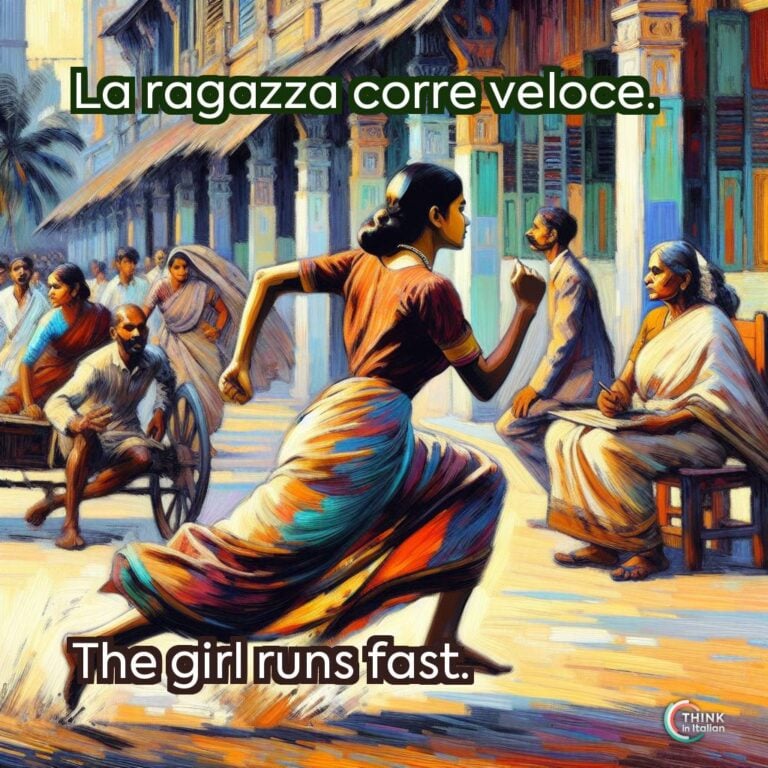The Italian Language
Type and Classification
Linguistically speaking, Italian is classified as a Romance language. This adjective means it evolved from the regional dialects spoken during the Roman Empire.
Another way you can call it is Neo-Latin language, because, as all Romance languages, it traces its roots back to Vulgar Latin. To be honest, I personally like the label “Romance languages” because I love the semantic link with romance as we mean it today.
At the same time, if we examine the Italian language from a typological perspective, several key aspects allow to categorize and understand its structure within the broader context of world languages.
It is classified as a fusional language: fusional languages use affixes (prefixes, suffixes, infixes, and circumfixes) to indicate grammatical relationships, often combining several grammatical elements (such as gender, number, case, or tense) within a single morphological form.
For instance, verb endings in Italian change according to the person, number, and tense, encapsulating a lot of information in a single word:
Parl-o Italiano.
I speak Italian
where -o conveys mood (indicative), tense (present), person (first), number (singular).
Syntax
Syntax is the set of rules in a language that tells us how to arrange subjects, verbs, and objects to create logical sentences. The typical sentence structure in Italian follows a Subject-Verb-Object (SVO) order, which is common among many world languages.
However, due to Italian’s relatively flexible syntax, these items can be reorganized to emphasize different parts of a sentence without losing clarity, thanks to rich verbal inflections and the use of contextual clues.
For instance, I bet you know that Italian is considered a Pro-drop Language, meaning that subject pronouns in Italian can be omitted because they can be inferred from the verb conjugation. The sentence I wrote above is a perfect example of this characteristic.
I personally noticed that, as a native Italian speaker, I almost never use subjects pronouns in Italian and that, when I do, it is because I want to really underline the subject. Therefore, if you want to sound as natural as possible, my advice is that you learn when to use subjects.
Another example to better understand Italian’s flexibility is the inversion mechanisms it makes use of to emphasize specific items of a sentence. This is one of my favorite aspects of Italian, because by simply inverting the usual order of words you can convey specific intensions and meanings.
Questa torta l’ha fatta Marco!
This cake, Marco made it!
With this specific order, the sentence is meant to convey the fact that Marco made the cake, not someone else!
Italian Grammar
Gender and Number
In Italian, gender and number are inherent and arbitrary grammatical characteristics which greatly influence the structure of sentences and categorization of concepts. Every article, noun, and adjective inherently has a gender (masculine or feminine) and a number (singular or plural).
For instance, the noun tavolo (table) is inherently masculine and singular. If you want to speak about more than one table, the word changes to tavoli. Similarly, the feminine noun sedia (chair) becomes sedie in the plural.
Adjectives and articles must consistently match the gender and number of the nouns they modify. For example:
Il tavolo nero.
The black table.
where both the definite article il and the adjective nero are masculine singular like the noun.
Verb Tenses
As a linguist, I can tell you: verbs are the most important part of a sentence. They select the corresponding and relevant subject and objects, therefore it is as if all the items in a sentence depended on them.
Italian verbs express a wide range of tenses, moods, and aspects. Understanding these linguistic features provides insights into the functioning of the Italian language, helping linguists and language learners grasp the underlying rules that govern Italian’s structure and use.
Before we dive into a detailed explanation of Italian verb tenses, let me spend some words on Italian verbs conjugations: Italian verbs are classified into three conjugations:
- First conjugation: verbs that end in -are (almost all of these verbs are regular)
- Second conjugation: verbs that end in -ere (all auxiliary verbs, including modal verbs, belong to this category and are irregular, as well as many other second-conjugation verbs)
- Third conjugation: verbs that end in -ire (generally divided into regular verbs and verbs with -isc)
Another important classification that will help you understand how Italian verbs behave is the division into finite and non-finite verbs. The former are verbs that are conjugated depending on a personal pronoun (subject), while the latter display no subject conjugation.
This distinction plays a huge role on pronouns placement, which I will not cover in this article but I strongly advise you to have a look at.
Learn more about when and why you should put pronouns at the end of a verb.
Now, instead of writing a long and confusing paragraph about Italian verb moods and tenses, I thought it would be easier to see them displayed in a table.
Finite Verbs
| Mood | Simple Verb Tense | Compound Verb Tense |
|---|---|---|
| Indicative | Presente (Present)
example: io mangio(I eat) |
Passato Prossimo (Present Perfect)
example: io ho mangiato(I have eaten) |
| Imperfetto (Imperfect)
example: io mangiavo(I was eating) |
Trapassato Prossimo (Past Perfect)
example: io avevo mangiato(I had eaten) |
|
| Passato Remoto (Absolute Past)
example: io mangiai(I ate) |
Trapassato Remoto (Remote Past)
example: io ebbi mangiato(I had eaten) |
|
| Futuro Semplice (Future Simple)
example: io mangerò(I will eat) |
Futuro Anteriore (Past Future)
example: io avrò mangiato(I will have eaten) |
|
| Subjunctive | Presente (Subjunctive Present)
example: che io mangi(that I may eat) |
Passato (Subjunctive Past)
example: che io abbia mangiato(that I may have eaten) |
| Imperfetto (Subjunctive Imperfect)
example: che io mangiassi (that I were eating) |
Trapassato (Subjunctive Past Perfect)
example: che io avessi mangiato(that I had eaten) |
|
| Conditional | Presente (Present Conditional)
example: io mangerei(I would eat) |
Passato (Past Conditional)
example: io avrei mangiato(I would have eaten) |
Non-Finite Verbs
| Form | Simple Verb Tense | Compound Verb Tense |
|---|---|---|
| Infinitive | Presente (Present Infinitive)
example: mangiare(to eat) |
Passato (Past Infinitive)
example: aver mangiato(to have eaten) |
| Participles | Presente (Present Participle)
example: mangiante(eating) |
Passato (Past Participle)
example: mangiato(eaten) |
| Gerund | Presente (Present Gerund)
example: mangiando(eating) |
Passato (Past Gerund)
example: avendo mangiato(having eaten) |
As you might have noticed, I divided the tables into two columns: simple and compound verbs. It is important that you grasp this distinction and the structural way compound verbs are formed:
Auxiliary verb (essere or avere) conjugated in the simple tense + participio passato
Verb Classification
Although it is usually not explained, I believe that an overview of the qualitative classification of Italian verbs is important to understand the Italian verbal system. Here I want to focus on auxiliary verbs only.
In linguistics, an auxiliary verb is a verb that adds functional or grammatical meaning to the clause in which it appears. They are also commonly called “helping verbs” because they accompany the main verb to help form various tenses and moods of the main verb.
The most common English auxiliary verbs are “to be”, “to have”, and “to do”, used to create forms like progressive tenses (is running), perfect tenses (has eaten), and negative or interrogative forms (do not go).
Italian auxiliary verbs are essere(to be) and avere(to have), used to create all Italian compound verbs, as I showed in the table above.
They are not classified among the standard three conjugations, but they are said to belong to coniugazione propria, literally translatable with “their own’s conjugation”, showcasing their unique behavior.
In both English and Italian – as well as many other languages – there also are other types of auxiliary verbs, namely modal verbs. They behave as auxiliaries, indicating a modality such as possibility, necessity, obligation, likelihood… but they are not used to create compound verbs.
Italian modal verbs are dovere, potere, sapere, and volere and they are always followed by a verb in the infinitive tense.
Voglio imparare l’Italiano!
I want to learn Italian!
Non posso uscire oggi, mi dispiace.
I cannot go out today, I am sorry.
Sai guidare anche la moto?
Can you drive motorcycles as well?
Devi leggere molto per imparare nuove parole.
You must read a lot in order to learn new words.
Italian Pronouns
In linguistics, a pronoun is a word that replace a noun or noun phrase, playing a crucial role in sentence construction as they allow to avoid repetition and make conversations more efficient.
There are several types of pronouns in Italian:
- Direct object pronouns: These are the object of transitive verbs. They are directly linked to the verb without the use of any preposition.
- Indirect object pronouns: These are the object of intransitive verbs. They are linked to the verb with the use of a preposition.
- Personal pronouns: You might know these as subjects. These are the Italian io, tu, lui/lei/Lei, noi, voi, loro. These pronouns are not relevant for the current topic.
- pronoun ci: Normally translated into “there”, is used for places.
- pronoun ne: Used to refer to topics and parts of amounts. It substitutes objects that are introduced by the preposition di.
In the table below, I will show you the distinction between direct and indirect object pronouns in Italian, given the fact that this distinction does not exist in English:
| Subject Pronouns | Direct Object Pronouns | Indirect Object Pronouns |
|---|---|---|
| Io (I) | Mi (me) | Mi (to me) |
| Tu (You) | Ti (you) | Ti (to you) |
| Lui/Lei (He/She) | Lo/La (him/her) | Gli/Le (to him/to her) |
| Noi (We) | Ci (us) | Ci (to us) |
| Voi (You all) | Vi (you all) | Vi (to you all) |
| Loro (They) | Li/Le (them) | Gli (to them) |
Notice that direct and indirect object pronouns can be combined together, resulting in a double pronoun structure. Also notice that pronouns placement is very important in Italian and depends on the type of verb you are conjugating.
Rule of thumb: pronouns precede finite verbs and follow non-finite verbs. There are some exceptions (check the behavior of the imperative mood with pronouns to know more), but it’s best if you look at them within each conjugation!
Why is it Important to Learn the Italian Grammar?
Mastering Italian grammar is crucial for anyone aiming to fully grasp the language. Something I always tell my students is: you cannot learn a language if you do not understand its mechanism!
Deep knowledge of grammar enhances fluency and enriches communication, affecting both clarity and stylistic nuance. For instance, verb tenses convey time, nouns and pronouns gender and number impact sentence cohesion, and adjectives and adverbs provide descriptive depth.
If you are not aware of how to use these grammatical elements, how can you expect to learn a language?
By mastering Italian grammar, not only do learners enhance their language skills, but they also deepen their cultural understanding, which allow for a richer engagement with Italy’s linguistic and cultural heritage.




